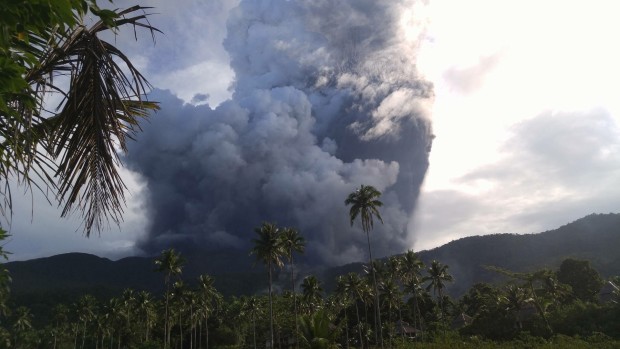Mt. Bulusan’s ashfalls threaten crops, people’s health in 3 Sorsogon towns

Mt. Bulusan belches out a 500-meter high column of ash around 3:35 p.m. Sunday (Oct. 23, 2016). (CONTRIBUTED PHOTO FROM THE OFFICE OF CIVIL DEFENSE 5)
BULUSAN, Sorsogon — Four times during the past week, Mount Bulusan in Sorsogon belched out gray ash plumes in a series of minor phreatic (steam-driven) eruptions that sent ashfalls over villages in the
towns of Bulusan, Casiguran and Irosin, threatening crops and endangering the health of some residents.
Antonio Bañares, 64, a resident of Barangay (village) Central in Bulusan town near the slope of the volcano said he had thought the ash falling from the sky last week was just drizzle.
“I became aware that it was ash and that the volcano had a (minor phreatic) eruption. I saw the ash thicken and I thought, this is bad, especially that I have a heart condition,” he said.
Bañares and other residents in 11 barangays in Bulusan have been inconvenienced by the volcano’s phreatic eruptions last Oct. 17, 19 and 21.
The Municipal Disaster Risk Reduction and Management Council (MDRRMC) of Bulusan said the villages of Dancalan, Madlawon, Poctol, Sapngan, Dapdap, Looban, Central, Sabang, Mabuhay, San Rafael and San Bernardo bore the brunt of the ashfalls, which reached .5 millimeter. The villages of San Jose and San Francisco were affected by volcanic fumes.
Article continues after this advertisementThe Philippine Institute of Volcanology and Seismology (Phivolcs) also found minimal traces of ashfall in upland barangays of San Rafael and Sabang in Irosin town during the Oct. 19 event.
Article continues after this advertisementIn Casiguran town, Luisito Mendoza, Casiguran’s MDRRM officer, said at least 350 households were affected by a 5-millimeter thick ashfall in Barangay Inlagadian from the Oct. 21 phreatic eruption.
“We had 10 residents given medical attention after they vomited and experienced stomach ache triggered by ash from Mount Bulusan,” Mendoza said. A medical team was deployed to distribute face masks and towels to residents.
“If the situation gets worse, we might order pre-emptive evacuation to assure the safety of residents living near the 4-kilometer (permanent) danger zone,” he said.
Nerma Ricero, principal of the Inlagadian Elementary School, cancelled the classes Friday after 310 students had difficulty concentrating on their lessons. Bulusan Mayor Mike Guysayko also ordered the suspension of classes in eight elementary and secondary schools.
Farmer Salvador Hajas, 33, said the continuing eruption of Bulusan volcano has sent ashfalls that destroyed their crops.
“Our produce are very much affected. They got rotten due to ash, for that we can’t sell them on good prices,” he said.
“We have yet to verify the number of the households that will be affected and that will be evacuated in case it (Mount Bulusan) erupts,” Renard Fullon Garados, Bulusan MDRRM officer, said.
Garados also said the residents and local government officials saw no cause for panic yet since the ashfalls had been minimal.
Ed Laguerta, Phivolcs resident volcanologist based in Legazpi City, said in a previous interview that the steam-driven eruptions have been a “normal occurrence” in Bulusan. Phivolcs has recorded at least 20 phreatic eruptions since May 2015.
“What we are closely checking is the presence of fresh magma expelled by the volcano, indicating that magma is developing beneath the vent,” he said.
Government volcanologists gathered ash samples every time the volcano erupted to determine traces of fresh magma particles, Laguerta said.
Garados, however, said volcanic ash has been harmful to those with weak lungs and asthma.
He added that the Bulusan MDRRMC had already supplied barangays with enough medicines to administer to residents who might need help.
The Phivolcs extended the permanent danger zone (PDZ) around Mount Bulusan from 4 kilometers to 6 km. The extension was ordered by Phivolcs Oct. 18 after the Oct. 17 phreatic eruption but it became effective Oct. 19 after the second event. Alert level one remains in effect over Bulusan volcano. SFM